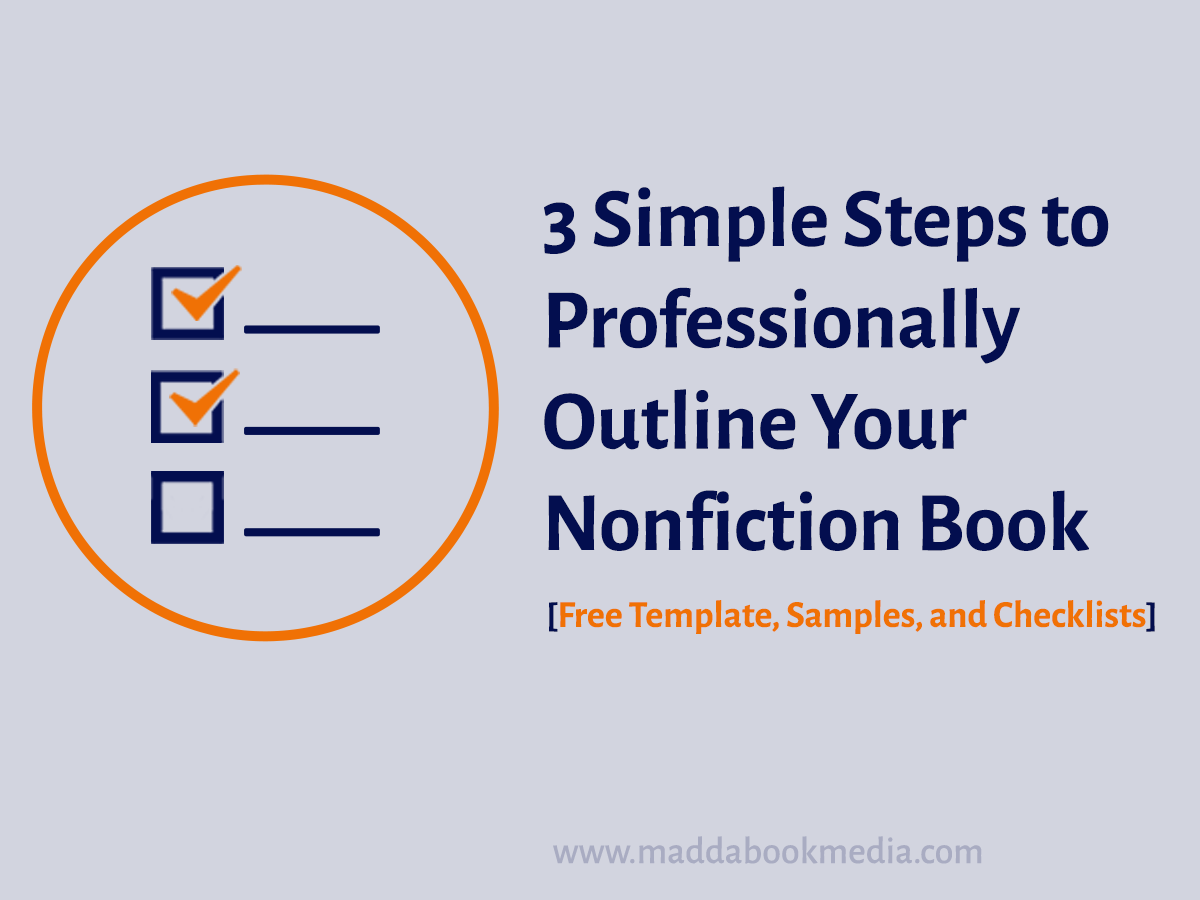There’s only one correct answer to the above question what makes a good nonfiction book outline?: a whole lot.
This post is for nonfiction authors (especially first-timers) who want to learn about the proper steps to a successful book and why outlining is the most vital step in the process.
Start by ditching all the book fads you’ve heard:
- Write your book in 14 days;
- Write and publish your book in one weekend;
- Write like a pro, publish like a legend in 2 hours.
It’s trash, and it’s your quickest route to getting scammed. Even if it seems to be working faster, best believe this; your result will be amateurish. Sure, you don’t want that.
Want to do a great book? There’s only one legitimate way: put in the work.
Jim Collins wrote Built to Last, considered by many as the definitive management book of the Nineties. Yet it took him the next six years to finish its sequel, Good to Great.
Rick Warren put much attention to Purpose Driven Life. It remains a top bestseller in its niche, with over 22 million copies sold as of 2020.
The best hack for cultivating the diligence required to do a great book is paying attention to the outline. Taking the time to do it right will help you garner the courage and discipline to finish your book.
Save yourself some good time and the pain of hit-or-miss creativity. Defeat stalling simply by outlining your book and doing it the right way. Here’s our free guide with a template and checklists.
Understanding the Outline
It is a piece of information organized into a synopsis.
Nonfiction books organize and present a clear message for readers to catch the lesson or advice you have learned. It’s also helpful enough to solve a particular problem.
An outline helps you determine whether your book is well designed to achieve those for the readers.
As a sum-up version of your book, you can see your entire narrative in a glance and how the unique points build into one big idea. In other words, you can tell if your message is working or not and precisely what to fix.
The Number 1 Writing Mistake
The most common mistake first-time authors make is starting Chapter One without a prearranged outline or synopsis.
Experienced writers have learned this lesson, mostly the hard way. So, they avoid creative pitfalls and time loss by planning their writing ahead.
Writing an outline isn’t easy, and it takes discipline to do and follow through on it. Seasoned authors know that all too well.
But, guess what? They also know that discipline will pay off in many valuable ways. For one, it will reduce your chances of writing too many drafts that aren’t working.
Also, it helps you build clockwork for your book project.
And the same discipline that helped you do your outline is what you need to finish your book. We have heard many great authors say that the outline is the most critical step in their writing process.
As an aside, I sketched an outline for this blog post before writing it. Take a look at the table of contents on the right side of your screen.
A great book isn’t just about the fantastic insights in it. It is a product of excellent decisions. Every step is more about making sound decisions than having a mush of great ideas.
That’s what you do with an outline—you plan both your content and decisions as you pursue your publishing prospects.
The most challenging part of the process isn’t finding your great idea. It’s making the right decisions. Your book rises or falls, not on its message, but based on sound and timely judgments.
The first best writing decision a would-be author could make is choosing to outline their book, as it saves a lot of time and effort.
Plus, you have an actionable plan—as your best weapon system against hold-ups at any point in the process.
Authors, especially first-time writers, can feel stuck at the beginning, middle, or end of the writing. Here are some reasons:
- Poor planning
- Procrastination
- Fear
- Lack of a support group
The lack of a clear, effective outline may be why you have been stalling and trying at it for a decade with no tangible success.
The Number 1 Book Marketing Mistake
Similarly, the most significant book marketing decision you could ever make is choosing a great title—this is the first and last step in a good outline.
Step One in your outline is choosing a working title. When you’re done with the manuscript, due to an increase in your clarity, you may drop the working title for something better or stick with it if it works best.
While working on the book When You Forgive Yourself, the author’s initial working title was I Choose to Forgive. Not a bad one at all, but we kept honing the central idea and progressing through clarity and book development stages.
By the time we had a publish-ready manuscript, the title had evolved into its final state, When You Forgive Yourself.
Although the keyword Forgiveness remained intact, the thematic focus shifted from pardoning others to self-forgiveness.
That’s what more clarity can do to your work, and I doubt we would have achieved that without the aid of our outlining tool.

The title is the earliest information potential readers will learn about your book, and that’s what nearly half of the readers use to decide whether or not to buy a book.
The above is especially true for first-time authors whose names aren’t famous yet.
As one study shows, book titles are the number one factor influencing buyer decisions in men and women and are responsible for a high proportion of all book purchases.
Equally, a poor title is the worst marketing mistake an author could make.
Your Outline Solves These Two Greatest Concerns
- Effective planning (making the best decisions for your book)
- Picking the best title for your book
Doing a book is about making the right decisions. And there are tons of choices you can’t escape, except if you’re comfortable with shoddy, amateurish work. Below are some immediate decisions you get to make.
- What is the one question my book seeks to provide an answer to?
- What do I want to get out of writing this book?
- What is my main message?
- Does this part work or not?
- Who is my primary audience?
- Where and how can I find them?
- Who’s best to edit my manuscript?
- When will I release it?
- Which cover design type will I settle for?
- Which publishing model works best for my niche and goals?
- Do my title and subtitle work best?
- Will I publish in eBook, paperback, or both?…
These questions are precisely what you answer in a solid outline—all the crucial writing and marketing decisions organized in one piece. And that has many benefits.
- Your outline is your project’s overview.
That’s everything from idea to launch. So, you never miss a detail, and you also assess what works, or not, at one glance.
Is Step X working? Stick with it. Does it lead to a dead-end? Switch course. Either way, your outline serves you; you don’t serve it.
- Your outline is your best execution resource.
Remember, a great book is about great decisions, and we solve for them in the outline. The second big reason for an outline is that it is for execution.
Planning is not enough. Without action, outcomes will remain as dreams. Many people dream of writing a book. But only less than 1% eventually complete a manuscript in real life and fewer publish their book.
The reason? Writing can be pretty darn complicated and daunting, and many things along the way could deter an author.
- Lack of clarity or writer’s block
- Procrastination
- Fear
- Lack of required guidance or support group.
To mention but a few.
Your best defence against all setbacks is an outline that clarifies your process. Because chances are, action always flows when you have enough clarity.
Free Outline Template
I recommend to you our professional nonfiction outline template. When you have a clear outline, likely, you will stick with it. More likely, too, you will finish your book and hit publish.
Facts are: writing a book is hard. But outlining makes it more feasible. Your outline eliminates potential issues that could stop your publishing dreams by illuminating a pathway to your ideas and process.
Most writing problems (70%+) are clarity-based. Like the type our authors use, a good outline solves nearly all of them. It helps, as a clarity resource, to organize a book’s content from the best angle: that of the micro audience.
It does that in the best, intuitive way. Our template is your surest failure-proof tool, and that’s not all.
It doesn’t just contain a table of contents and chapter synopsis; it also helps you clarify your main objective. What do I want out of this book when I release it? This goal is vital to keep you motivated.
Keeping a big picture before you—something more compelling than staring at your name on the front cover—helps stimulate action. Also, your efforts will feel more meaningful, more intentional.
NOTE: Our format is best for nonfiction books only.
The Best Outlining and Book Writing Software
The standard industry software for outlining and writing your book is Microsoft Word. Trust me, it’s all you’ll ever need.
Any other piece of software won’t make your writing easier or better. At best, they’re merely fanciful.
Except you’re highly familiar and comfortable working with it, more software could strangle your work.
The best software you need is the one you’re already used to. The one that makes you write. Some authors have reported that PowerPoint helps them do a better outline.
It’s as I said, stick to what works for you. And simpler is always better.
From Outline To Manuscript (First Draft)
Experts have listed clarity, length, and flow/coherence as the three most prominent problems of all nonfiction writing, including good books.
So, we developed a template that solves these, and more, from both the author’s and audience’s viewpoints. The goal is to make life easier for you and guarantee your book doesn’t come out cheap.
You’d notice that the chapter section of the template is highly synthesized and forces you to get clear on every point you’re making. That’s deliberate.
This approach ensures that the narrative texts are written based on design.
Narrative texts are the words that will appear in your written draft under each point, also known as body text.
When writing your first draft, treat every component in a chapter as a separate element. But ensure you stick with your main idea and tailor it to your audience.
We recommend opening a new folder for each chapter and a new document per point. This method saves you countless hours of work during the editing stage.
This is how to move from outline to manuscript. It’s also a more productive way to organize your work.
Copy each part of body text and plug them under their respective point headings or topics when you’re done. Save up your entire Chapter One as a single file. Then proceed to Two. Follow the same method till the last chapter.
But resist the temptation of editing along the way. Keep writing; only think about editing after you have typed THE END.
More Book Outline Tips
1. Fixing Issues
If something is wrong in your draft, the problem is not with the piece or chapter. Don’t highlight and press delete. Go to your outline, diagnose the issue there, and fix it. Then come back to your draft and continue writing.
2. The 24-Hour Tip
The outline grows as your draft grows. It does not need to be perfect at the beginning. It just needs to show clear points of your book synopsis.
And that takes only 24 hours. Once you have that done, on Day Two, start with the first chapter you want to write.
3. The Stepwise Sequence
The best way to present your book message is in a stepwise format. Commercial (or non-literary) nonfiction books are usually written for the following reasons.
- To solve a pain point (How-To and Self-Help books)
- To teach a set of steps in accomplishing a definite result (Business, Leadership, and Personal Development books)
- To present facts around a given subject and what they imply (Academic/Investigative/Journalism/Intellectual Adventure)
- To share a new perspective (Science books/Some Self-Helps)
- To tell a story and truth learned by experience (Memoirs/Narrative Nonfiction).
- To share helpful advice to the reader in a specific area of interest (Guide Books)
One vital writing trope for you is the book prescription commonly used in the broad genres of how-to, business, and personal development books.
That is the steps you’re offering the reader if they must get the outcome your book promises them.
It’s vital to lay out all your steps and main points from the outline stage. This is the essential ingredient in your outline’s chapter section.
More Book Writing Tips
1. First Draft
Your outline is your book’s skeleton; it consists of only the main points and subpoints. Don’t add the sentences yet.
You flesh up your existing skeletal model during the first draft by adding body text. But it’s also not yet time to apply your cosmetics and dressing, as there will be ample time for all those when you’re editing.
2. Research
You don’t need research to pull off the first draft if you know your subject area enough. Extra research should come after the first draft, not before it.
Research does not supply the content or narrative text to your message; research is mostly for evidence-telling, objective backup, and statistical solidity.
You can best do that when there is a manuscript in your hand, not before it. Much research won’t help you write your draft, and it can stall you.
3. Marathon of the Middle
The marathon of the middle is just a fancy way of describing the middle of your writing.
From experience, most authors get stuck in the middle because they are making some new findings or getting further clarity and aren’t sure how to proceed. Especially considering their outline.
Here’s a piece of advice: you don’t serve your outline; it serves you. Remember this principle, and you will cross the marathon of the middle with ease.
Please don’t change the entire book because of a minor glitch. Locate and fix it in the outline.
4. Book Teams and Co-Authors
Writing a great book involves several minds—besides, a support group can prove helpful.
People will get involved somewhere in your book process, whether as members of your research team, alpha or beta readers, co-writers, fact-checkers, reviewers, a developmental editor, or even advance readers.
At Madda, we help our authors assemble the perfect book team for their project from our talent pool.
Suppose you’re working with a book team or a co-author. Then your outline will serve as the executive document of the project for all to be on the same page.
Also, y’all don’t need to go through a lengthy finished draft to locate and discuss a point. Your outline offers a micro view throughout the project.
Also, watch out for our article on Book Teams v. Co-authors; Which one should you choose, when, and why.
5. Beyond the Outline
Frequently, people ask, doesn’t outlining inhibit my flow? In the sense that it makes their work too rigid or boxes their minds, or prevents creativity.
And the answer is always that it does the opposite; it aids your flow.
In book writing, your biggest challenge is not getting inspiration. If you are a master in your field, you already know much more than you need to put into a book.
Your worst enemy is stalling or not finishing your draft due to second-guessing your insights or authority in the field (aka, impostor syndrome).
The truth is, for a book, creative expression is secondary to solving the reader’s pain point.
Readers will care more about your book if it solves their concerns and is simple to read and follow.
Lyrical prowess won’t come first on their mind, except if that’s what your book is about.
In that case, flowery language will be a good plus. Overall, try not to be too rigid with the outline; it serves you. Use it the best way you can, including going beyond it when necessary.
6. Rewriting and Editing
No book at the time of publishing is the same as its first draft or outline. Hardly.
Rewriting and editing are the processes by which you polish your work. Expect to keep improving on your outline and draft.
Expect to further clarify your idea in its logic and presentation levels.




